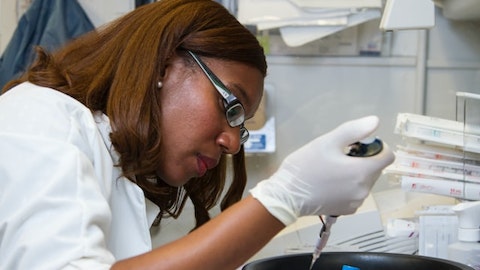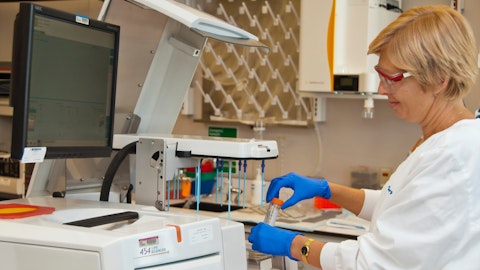Nektar Therapeutics (NASDAQ:NKTR) Q3 2023 Earnings Call Transcript November 7, 2023
Nektar Therapeutics misses on earnings expectations. Reported EPS is $-0.24 EPS, expectations were $-0.18.
Operator: Good day and thank you for standing by. Welcome to the Nektar Therapeutics Third Quarter 2023 Financial Results Conference Call. [Operator Instructions] Please be advised that today’s conference is being recorded. I would now like to hand the conference over to your speaker today, Vivian Wu. Please go ahead.
Vivian Wu: Thank you, Crystal, and good afternoon, everyone. Thank you for joining us today. With us on the call are Howard Robin, our President and CEO; Dr. Jonathan Zalevsky, our Chief of Research and Development; Dr. Mary Tagliaferri, our Chief Medical Officer; and Jennifer Ruddock, our Chief Business Officer. Unfortunately, Sandra Gardiner, our acting Chief Financial Officer was not able to make it on today’s call due to an unexpected family emergency. On today’s call, we expect to make forward-looking statements regarding our business, including statements regarding the therapeutic potential of and future development plans for drug candidates and research programs. The timing of the initiation of clinical studies and the availability of clinical data for drug candidates, the timing and plans for future clinical data presentations, the formation, future development plans or success of our collaboration agreements, the expectations following our corporate restructuring and reorganization, financial guidance and certain other statements regarding the future of our business.
Because forward-looking statements relate to the future, they are subject to uncertainties and risks that are difficult to predict, many of which are outside of our control. Our actual results may differ materially from these statements. Important risks and uncertainties are set forth in our Form 10-Q that was filed on August 9, 2023, which is available at sec.gov. We undertake no obligation to update any of these forward-looking statements, whether as a result of new information, future developments or otherwise. A webcast of this call will be available on the IR page of Nektar’s website at nektar.com. With that said, I would like to hand the call over to our President and CEO, Howard Robin. Howard?
Howard Robin: Thank you, Vivian, and thank you all for joining us today. In the third quarter, we made substantial progress in advancing our development programs. First, on REZPEG, we’re pleased to say that we began initiating our first clinical sites in October for the Phase 2b trial of REZPEG in patients with atopic dermatitis. We expect the first data from this study on the primary endpoint of EASI reduction over the 16-week induction period sometime in the first half of 2025. The strength of our data from the randomized Phase 1b study gives us much optimism that we will be successful in the Phase 2b study. These data were recently presented at the 2023 EADV meeting in an oral late-breaking news plenary session, and JZ will summarize some of the new data presented later on in this call.
But importantly, we observed a consistent benefit with monotherapy REZPEG across multiple clinical efficacy endpoints and patient-reported outcomes. As Dr. Silverberg mentioned in his plenary talk, the Phase 1b trial of REZPEG is the first randomized placebo-controlled study to offer an exciting proof of concept for the important role of T regulatory cells in treating autoimmune disease. And it was exciting to see that this benefit was maintained for many patients through 36 weeks after treatment ended. This substantial benefit observed with REZPEG could eliminate the need for frequent maintenance dosing for patients with atopic dermatitis, and it positions REZPEG with its novelty regulatory cell mechanism as a potential new treatment option, which could be highly disruptive in the biologic treatment landscape for atopic dermatitis.
The biologic market for atopic dermatitis is a multibillion dollar market and growing. This landscape includes many IL-13-based mechanisms, which overlap with one another. And REZPEG offers the unique promise of a new mechanism in this landscape and a new treatment paradigm that is well tolerated. This is why we’re so optimistic about REZPEG’s potential. Our goal is to ensure enrollment proceeds on track to deliver data from the randomized Phase 2b trial on our planned time line in the first half of 2025. This past quarter, we expanded our plan for a second study in alopecia areata from its original randomized Phase 2a study design in approximately 40 patients to a randomized Phase 2b study design in approximately 80 patients. This is consistent with standard studies in this area and the incremental cost of this study is still within our projected budget.
Importantly, this study will read out around the same time as the atopic dermatitis study. We believe there’s an opportunity for REZPEG to become a novel biologic mechanism in alopecia, which has no currently approved biologic treatments and JAK inhibitors are the primary treatment mechanism. We know JAK inhibitors have cardiac safety concerns and patients experience a rebound after discontinuing therapy. So there’s a high unmet medical need for those patients for a new treatment option. With the collective data we’ve generated to date on REZPEG in atopic dermatitis and other autoimmune diseases, we believe there is a strong scientific rationale for REZPEG with its Treg mechanism in action to be able to address the underlying pathogenesis of alopecia, and JZ will discuss the scientific rationale for this study in a moment.
We plan to submit the IND for this study to the FDA by year-end and we expect to initiate the study shortly thereafter. We’re also continuing to advance our preclinical programs in immunology, including our TNFR2 agonist antibody that offers a promising mechanism for multiple sclerosis, ulcerative colitis and other autoimmune indications as well. Our goal is to submit an IND for this antibody program in 2024. Moving on to NKTR-255, we are pleased to have recently announced our new clinical study collaboration with Cellular Biomedicine Group, also known as CBMG to evaluate NKTR-255 in combination with CBMG’s TIL therapy in lung cancer patients that don’t respond to anti-PD-1 therapy. CBMG is adding NKTR-255 to its ongoing Phase 1 study being conducted at Duke University Cancer Institute and other investigator sites in the U.S. We’re also continuing our other clinical work with NKTR-255 while we evaluate additional strategic partnership pathways for the program.
We ended the quarter in a strong financial position with $373 million in cash. And as I stated earlier, we are well positioned to be able to advance our planned clinical studies while maintaining a cash runway into the middle of 2026. The goal is to reach multiple value-enhancing Phase 2 milestones for REZPEG in the first half of ’25 and we believe we are well positioned to execute on this. Since many of you have been asking about the status of our litigation with Lilly, I’ll make a brief comment that we continue to actively pursue the litigation and remain confident in our legal position. With that, I’ll hand the call over to JZ for an R&D discussion. JZ?
Jonathan Zalevsky: Thank you, Howard. Starting off with our lead immunology program, REZPEG. As Howard stated earlier, this program is uniquely positioned as the most advanced IL-2-based Treg mechanism in the clinic and has potential in multiple autoimmune diseases, including our current focus areas of atopic dermatitis and alopecia areata. Last month, Dr. Jonathan Silverberg presented compelling data for REZPEG from the Phase 1b trial in atopic dermatitis during a late-breaking abstract session at the 2023 EADV congress. This presentation of the final study results for that trial highlighted the potential of REZPEG for the treatment of atopic dermatitis. Through the 12-week induction period, REZPEG demonstrated dose-dependent efficacy across both physician-assessed and patient-reported efficacy measurements, reaching statistical significance across many of these measures.
Importantly, we are encouraged by the extended durability seen for REZPEG, long after the completion of the 12-week induction period. Many patients maintain durable disease control for an additional 36 weeks after the end of dosing. And this type of extended disease control after the end of dosing is not observed for Dupilumab or for JAK inhibitors. Time to response was rapid with over 40% of atopic dermatitis patients, achieving EASI 75 by week three after only two doses of REZPEG at the highest dose level. REZPEG’s rapid onset of action, rivals that of JAK inhibitors, which have outperformed Dupilumab in head-to-head studies to date in this regard. Durability of the EASI 75 response was also observed with approximately 70% of EASI 75 responders maintaining their response for 36 weeks after the end of the 12-week induction period.
This is a very exciting result and suggests that REZPEG has the potential to be the first immunotherapy for atopic dermatitis. Additionally, REZPEG was well tolerated and treatment with REZPEG did not induce antidrug antibodies in patients, which has been reported with some examples in the IL-2 mutein class. Compared with placebo, there were sustained increases in absolute numbers of circulating total and CD25bright Tregs in the REZPEG treatment arms. The big increase in CD25bright Treg number was tenfold above baseline at the highest REZPEG dose group. Despite a shorter than typical induction period of 12 weeks, as compared with a 16- to 24-week induction period for most other biologics, there were clear improvements for all efficacy endpoints, including EASI scores, the vIGA, BSA, Itch-NRS, DLQI and POEM.
These improvements begin as early as weeks two to four and continue through week 12 of treatment. To give you some perspective, with historical studies in atopic dermatitis at the lower dose level of REZPEG, the improvements we saw were similar to those observed for biologic therapy. And at the higher dose level, REZPEG demonstrated a comparable activity to those reported with JAK inhibitors. The 83% improvement in EASI score for baseline observed that only 12 weeks of induction with REZPEG was superior to what was seen in the Dupilumab studies after 16 weeks. These promising data have us and KOLs very enthusiastic about the potential for long-lasting responses and the frequent maintenance dosing with REZPEG in the setting of atopic dermatitis.

The results we have obtained so far with REZPEG are significant for a number of reasons. Firstly, before this work was conducted, relatively little was known about the ability to restore Treg function to reverse immunological pathogenesis and improve the severity of dermal or cutaneous diseases. Now with REZPEG and its Treg mechanism, we have demonstrated clinical efficacy against the cutaneous manifestations of lupus, psoriasis and atopic dermatitis. These results begin to validate the Treg mechanism for the treatment of multiple pathologies of the skin. REZPEG’s attractive mechanism employs the body’s own immune system to restore tolerance by inducing the Treg pathway and presents a novel approach differing from the available broad or targeted strategies to block inflammatory pathways in dermal diseases such as atopic dermatitis.
Secondly, our hypothesis is that administration of the agonist drug REZPEG, induces Treg expansion and engages multiple immunoregulatory mechanisms to facilitate immune tolerance and regulation by attenuating Th1, Th2 and Th17 effector T cells, suppressing antigen-presenting cell activity and fostering tolerogenic dendritic cells. We believe this science translate to the durability of response we observed in the atopic dermatitis trial and is the differentiating element that allows us to pursue in every three month dosing regimen in our ongoing Phase 2b atopic dermatitis study. Biologically speaking, REZPEG through its central pathway of Treg rescue is uniquely poised to address the diversity of immunopathology, giving a broad potential for targeting multiple dermal diseases, including atopic dermatitis, alopecia areata and others.
In October, we initiated the Phase 2b study of REZPEG in biologic-naive atopic dermatitis patients. Our goal is to enroll roughly 400 patients with three different regimens of REZPEG versus placebo, evaluated over a 16-week induction period. After the induction period, patients that meet a threshold to advance from induction to maintenance will be rerandomized into one of two maintenance regimens at different dosages at either once a month or once every 3-month dosing schedule that will continue for another 28 weeks. We expect this study will take approximately 54 weeks to conduct, and we expect data in the first half of 2025. We also plan to initiate a Phase 2b study of REZPEG and alopecia areata later and early next year. Alopecia areata is an indication with a high clinical unmet need for a biologic as the only approved agents or JAK inhibitors, which come with a black box warning and lack durability after cessation of dosing.
For these reasons, we believe there’s an opportunity for REZPEG to become a novel biologic therapy in alopecia areata. And as I just mentioned, we believe that REZPEG and its Treg mechanism of action is great potential for addressing this indication, which is essentially a dermal disease of the scalp. Across all of our studies, with nearly 600 people treated, REZPEG demonstrates a consistent and highly predictable Treg cell pharmacodynamic profile in different autoimmune disease pathologies and even in healthy volunteers. Taken together, we believe there is strong rationale for REZPEG for the treatment of alopecia. The Phase 2b study plans to recruit roughly 80 patients with moderate-to-severe alopecia that will be randomized to REZPEG or placebo.
As Howard mentioned, while it was previously our plan to run a Phase 2a trial with roughly 40 patients after reviewing historical trials in this indication, we decided to increase the size of our study to achieve a Phase 2b design at minimal incremental cost. Patients will be treated for a period of 36 weeks and observed up to 48 weeks in total. Our primary endpoint for this study is mean percent improvement in salt or the severity of alopecia tool at week 36, which is very standard in the field. We will also be looking at a number of other secondary endpoints, including proportion of patients who saw a reduction in salt. Now turning to our lead immunology research program, a TNFR2 agonist antibody program. TNFR2 is highly expressed on Tregs, neuronal cells and others, and TNFR2 agonism has been shown to potentiate the suppressive effect in overall functional properties of Tregs.
If TNFR2 is absent, it is associated with autoimmunity and other genetic conditions resembling FoxP3 loss of function. In contrast, its presence has been associated with immunoregulatory function and protective effects for multiple cell populations and tissues in the body. Building upon what we know the potential of regulatory T cell mechanisms, this makes this program incredibly exciting to us. Nektar has identified two lead antibodies that we have now validated for selected TNFR2 binding, cell type specificity in TNFR2 agonism in primary human cell-based assays. We believe that a selective TNFR2 agonist holds great promise for the treatment of multiple autoimmune diseases and are aggressively pursuing this program and on track to submit our IND in 2024.
And now I’d like to turn the call over to Mary to provide a brief update on our NKTR-255 program in oncology and our recent collaboration with CBMG. Mary?
Mary Tagliaferri: Thank you, JZ. Moving to NKTR-255, we are continuing our work with NKTR-255 while we evaluate strategic partnering pathways. We believe there is a potential broad application for NKTR-255 to enhance the efficacy of cellular therapies. And to that end, as Howard mentioned earlier, we are pleased to have recently announced our new clinical study collaboration with a leading cell therapy company, Cellular Biomedicine Group to evaluate NKTR-255 in combination with their TIL therapy known as C-TIL051. The study, which is being conducted by and fully funded by CBMG is in advanced non-small cell lung cancer patients who do not respond to anti-PD-1 therapy. With few treatment options for these individuals, we are excited about the potential for this regimen to help patients.
Preclinical and early clinical data suggest that IL-15 can improve proliferation and persistence of cellular therapies, such as TIL to increase specific anti-tumor activity. The first investigator site is at Duke University, with a leader in the lung cancer research field, Dr. Scott Antonia. Positive data from this study could lead to exploration of a pathway for accelerated approval by our partner, CBMG. Our other studies are continuing in cell therapy, and we expect that we could see data reported next year from these trials, including the Phase 2 JAVELIN Bladder Medley Study, which is being conducted and funded by our partner, Merck KGaA. Because of its unique potential as a combination agent with cell therapies and other mechanisms, we are exploring the best partnering and development path for continued development of NKTR-255.
And with that, I will turn the call over to Jennifer for a review of our financial guidance. Jennifer?
Jennifer Ruddock: Thank you, Mary, and good afternoon, everyone. We ended the third quarter with $373 million in cash and investments with no debt on our balance sheet. We now expect to end this year with at least $320 million in cash and investments, slightly higher than our prior projection of $315 million. As we had previously announced earlier this year, we reduced our San Francisco-based workforce by approximately 60% and this personnel reduction represents approximately $30 million a year in operating expense reduction. The costs related to the restructuring were substantially paid in June. We will fully realize annual savings in 2024 as a result of this restructuring. And our financial position remains strong with a cash runway that extends into the middle of 2026.
Importantly, this runway will take us through several key value-generating milestones for our pipeline. In Q3, we recorded a $10 million non-cash impairment charge for real estate leased assets in San Francisco, which contributed $0.05 to our net loss per share in the quarter. As a result, for the full year, we now expect to recognize restructuring, impairment and costs of terminated programs of approximately $50 million to $55 million, which includes $37 million of non-cash impairment charges recognized through the first nine months of 2023. There is more detail on this in our Form 10-Q, which is being filed this afternoon. We now expect G&A operating expense for the full year of 2023 to be between $80 million and $85 million, which includes approximately $15 million to $20 million of non-cash depreciation and stock comp expense.
Our GAAP revenue for full-year 2023 is still expected to be between $80 million and $90 million. This revenue includes $65 million to $70 million in non-cash royalties and $15 million to $20 million in product sales. We anticipate full-year GAAP R&D operating expenses will range between $105 million and $115 million, which includes approximately $15 million to $20 million of non-cash depreciation and stock comp expense. Our full-year non-cash interest expense is expected to be between $20 million and $25 million. As I stated earlier, we expect to end this year with at least $320 million in cash and investments. And with that, we will now open the call for questions. Crystal?
See also Wall Street Analysts Are Downgrading These 10 Stocks and 10 Stocks Getting a Huge Vote of Confidence From Wall Street.
Q&A Session
Follow Nektar Therapeutics (NASDAQ:NKTR)
Follow Nektar Therapeutics (NASDAQ:NKTR)
Operator: [Operator Instructions] And our first question will come from Jay Olson from Oppenheimer. Your line is open.
Jay Olson: Hi, congrats on the progress, and thanks for providing this update. Can you talk about the Phase 2b trial in atopic dermatitis? And congrats on the initiation of that study. Can you just talk about the feedback you’re hearing from investigators? When do you expect to provide some guidance on enrollment rates? And when do you expect to complete recruiting for that study?
Jennifer Ruddock: Yes, Thanks Jay. I’m going to ask Mary as she’s been meeting with a lot of these investigators over the past couple of months to comment on that. Mary?
Mary Tagliaferri: Thank you, Jennifer. And thank you Jay for asking the question. We recently attended EADV in Berlin, and we were able to meet with 30 different investigators, mostly from Europe. And we’re going to recruit this trial at 100 different clinical sites in the United States, Canada, Europe and Australia. And I can tell you that the investigators are very excited about REZPEG, the mechanism of action and its application in atopic dermatitis. The presentation that Dr. Jonathan Silverberg made was very well attended and very well received. And Jonathan Silverberg mentioned that for many years, we’ve known the importance of T regulatory cells, but we had never seen any data from a drug that actually expands T regulatory cells to improve dermal indications such as atopic dermatitis and with an 83% reduction in the mean EASI score from baseline, this was what he calls best in industry.
So there is a widespread enthusiasm from the investigators. I will tell you that a couple of other things that are very compelling about our clinical trial are the following. Number one, we have a very good safety profile. Our drug is highly tolerable, and we’ve now shown that in roughly 600 patients. Number two, they really like the idea in the maintenance setting that we’re going to evaluate a monthly and a 3-monthly maintenance regimen. And number three, the fact that their patients are going to be able to continue to receive REZPEG beyond the induction period of 16 weeks is very attractive to their patients and to the investigators as well. So we feel that we will absolutely be able to deliver this trial on track and on time with data — topline data available in the first half of 2025.
I hope that answers your question.
Jay Olson: Super helpful. Thank you so much for the details. Yes, and we’ll look forward to future updates. On the Phase 2b study of REZPEG and alopecia areata, can you just talk about how you’re thinking about dosing? And then what’s the bar there to initiate a Phase 3 study? And how will you compare the performance of REZPEG with recently approved oral drugs in alopecia?
Jennifer Ruddock: Mary or JZ, would you like to take that?
Mary Tagliaferri: Sure. I’m happy to address that. So the JAK inhibitors, as you know, are efficacious. We see an effect after roughly 36 weeks of treatment. There are, as you know, many problems with JAK inhibitors. One, when you stop taking the JAK inhibitors, patients very rapidly lose their hair. And of course, you’re well aware that their black box warning with the JAK inhibitors. We very closely looked at the baricitinib data, and we believe if we have efficacy similar to baricitinib, but don’t accompany two things: one, a rapid loss of hair after cessation of treatment or the ability to have, again, just like we’re looking at in atopic dermatitis, a maintenance regimen that is far more convenient and favorable for the patient, we believe that a biologic would have great appeal in the area of alopecia areata.
We are going to look at two different doses versus placebo and we will evaluate this at 36 weeks. And again, I think, analogous or better efficacy than has been seen with the JAK inhibitors with an improved safety profile, tolerability profile and without accompanying black box warnings would make REZPEG highly competitive in this space.
Jay Olson: Great, thank you for the super comprehensive responses, and congrats again on all the progress.
Mary Tagliaferri: Thank you very much, Jay.
Operator: [Operator Instructions] And our next question will come from Chris Shibutani from Goldman Sachs. Your line is open.




